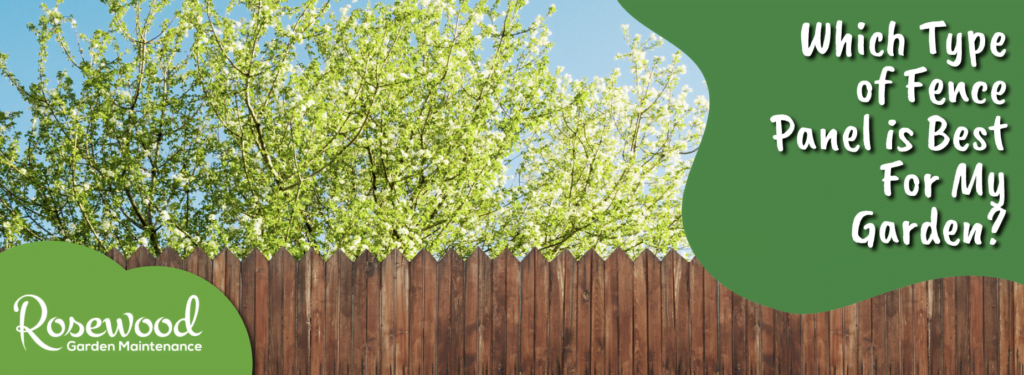
Picking the perfect fence panel to secure your garden and complement your outdoor space can be tricky as there are so many different styles. In our latest blog, we look at four varieties of fencing options and outline their benefits and disadvantages to help you make an informed decision.
Bear in mind though, the positive qualities of a new fence are only applicable if good quality timber is used and the fence is put up properly. This is where a professional garden maintenance company comes in (like us!)
Featheredge Fence panel
The term ‘featheredge’ refers to the panels that run from top to bottom and are attached to horizontal rails. They are called ‘featheredge’ because they taper; one edge is thicker and it gradually becomes thinner, like a feather.
This type of fencing is very popular (we certainly get asked to erect a lot of feather edge fencing here at Rosewood). This is mostly due to the fact that it can be put up very quickly, is extremely durable, strong and secure, and offers great privacy.
Pros
- Robust and long-lasting
- Its height (usually 6ft) provides some security
- Provides privacy
- Good for pet-owners
- Offers shade and shelter for tender plants and shrubs
Cons
- Its closed-up boards can be buffeted by strong winds, though it’s stronger than a larch lap fence panel
- Maintenance required
Larch lap fence panel
A common type of budget fencing made from overlapping horizontal panels. Although offering good value, larch-lap panel fencing is not as robust as close-board fencing, being more prone to damage in high winds.
Pros
- Suitable for most gardens
- Cheaper than close-board fencing
- Provides privacy
- Deters intruders
- Ideal for homes with pets
Cons
- Not as robust or long-lasting as close board fencing
- Maintenance required to prolong the life of the timber
- Functional, but less attractive than other styles
Timber picket fencing
If you want a traditional, decorative look, timber palisade or ‘picket fencing’ is a good option. This type of fence is mostly seen in front gardens. Although wood is the conventional material, picket fencing can also be made from PVC for a lower maintenance option. However, there are a few disadvantages to this. Temperature changes can make it brittle, prone to mould and it can also be more expensive than wood.
Pros
- Ideal to protect ponds or swimming pools
- Provides a good boundary marker
- Traditional, attractive looks
- Lets light through / doesn’t block your view
- Less prone to wind damage
Cons
- Doesn’t provide privacy
- Doesn’t provide much security
- Would not contain some dogs
- Won’t provide much protection for plants
Slatted Fence Panels
Slatted fence panels give a more sleek, contemporary look to your outside space, ideal if privacy is not an issue. They can make great dividers for different sections of your garden. The effect of sunlight slanting through the gaps is also very pretty!
Pros
- Available in a range of heights and styles
- Sleek, modern appearance
- Horizontal slats can make your garden appear longer
- Gaps between slats allow wind through, reducing resistance and improving longevity
Cons
- Don’t offer complete privacy on a boundary
- Can let weeds grow through
A note from us here at Rosewood
Once you’ve made a decision about what type of fence panel is best for your garden, the next step is deciding whether you’re going to do a DIY job, or call in the professionals to get the job done quickly and efficiently. Here at Rosewood, we can erect any type of fence you’d like. We can also treat, stain or paint it depending on what would look best in your garden. To get in touch with our team, please give us a call on 07393 82797, or alternatively, follow us on Instagram or Facebook to keep up with our team’s hard work.














